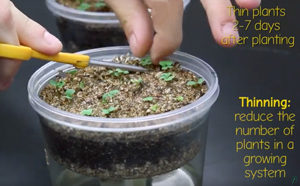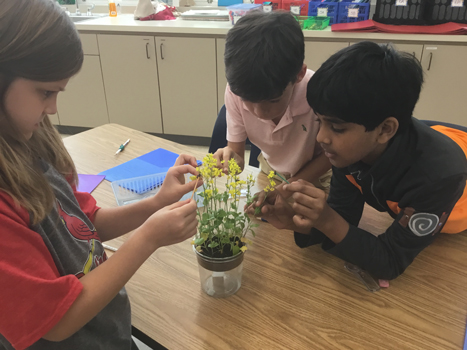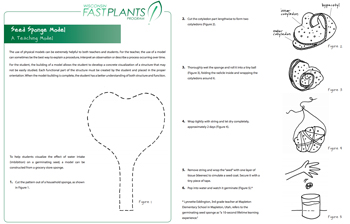Classroom teacher, Julie LaConte, tells about her first experience teaching with Fast Plants in this guest post. Thank you, Julie, for sharing your insights and experiences!

Students thoughtfully observe their Fast Plants.
Fall 2019 was my first experience teaching with Fast Plants, and plants are one of my least favorite topics to teach. After 18 years as an upper elementary and middle school science teacher, I have had my fair share of plant experiment failures to be more than wary of most plant-based curricula. While I understand the importance of teaching about plants and the value of incorporating hands-on, inquiry-based lessons about plants, the logistics, time, materials, and requirements for growth are often not conducive to a classroom setting. I am completing my semester’s first experience, using the Wisconsin Fast Plants Elementary Exploration of Plant Life Cycles Kit and am happy to report that this has become one of my new favorite units to teach!
I was introduced to the Fast Plant program in the spring of 2019 at the National Science Teaching Association’s national conference in St. Louis, MO. Our 4th grade curriculum includes an examination of the classification of living things and focuses specifically on mammals and plants. Our school is also lucky to have a greenhouse attached to it where we have been growing lettuce that is then used in our cafeteria. I was looking for a new way to integrate both our greenhouse and a hands-on investigation of plants in our 4th grade life science unit. After attending several sessions and speaking with representatives about the Wisconsin Fast Plants, I realized that this was a potential solution for my needs.
I ordered the Wisconsin Fast Plants Elementary Exploration of Plant Life Cycles Kit from Carolina Biological, as well as a supplemental teaching guide “Teaching with Fast Plants,” and a light bank (Fast Plants need 24-hour, high-intensity light and grew in my classroom, not in the greenhouse). Admittedly, I was nervous for my first experience and slightly skeptical about whether this system was going to work. I spent a great deal of time on the Wisconsin Fast Plants website and looking through their available resources and articles. My main concern was the validity of the process. I was nervous that I was going to plant the plants according to the directions, things weren’t going to happen as described in the teacher’s manual, and then what would happen to my lessons each day? Much to my relief, the system is working exactly as described! I have been able to teach about the parts of plants, plant life cycles, and plant reproduction processes in an authentic and concrete way that has been engaging and exciting for my students.
One of the aspects of the curriculum that I particularly enjoy is the flexibility to incorporate mini-lessons throughout the unit. Inevitably, there is a waiting period (even for Fast Plants) while the plants sprout, flower, create seeds, etc. During those “down times” while we’re waiting for the life cycle processes to take place, I have been able to incorporate lessons that use the Fast Plants as a model for the concepts we’re learning. While this was intimidating for my first experience with Fast Plants (“what am I going to teach while we’re waiting for the flowers to bud??”), I have discovered that this is one of the most important aspects of the program.
For example, at the beginning of the life cycle process, after planting our seeds, we had to wait a day for the sprouts to appear. During this time, I used the “Seed Sponge” activity from the “Teaching with Fast Plants” to teach about germination (watch this seed sponge video). This provided a concrete model for the students to understand the parts of a seed, what seeds require to sprout, and how germination occurs. And it gained a lot of “oohhs” and “ahhs” because it looks pretty cool while it’s happening!
 A few days later, we were instructed to thin the number of seedlings in the pot. While doing that, we completed a supplemental experiment called the “Hypocotyl Hypothesis” from the “Teaching with Fast Plants” guide and explored the concepts of heliotropism and gravitropism. I was nervous about this one and even admitted to the students I wasn’t sure if it would work. It did, and the students and I saw a powerful bit of evidence of the ability of plants to adapt to their surroundings.
A few days later, we were instructed to thin the number of seedlings in the pot. While doing that, we completed a supplemental experiment called the “Hypocotyl Hypothesis” from the “Teaching with Fast Plants” guide and explored the concepts of heliotropism and gravitropism. I was nervous about this one and even admitted to the students I wasn’t sure if it would work. It did, and the students and I saw a powerful bit of evidence of the ability of plants to adapt to their surroundings.
Probably the biggest benefit I have experienced with the Wisconsin Fast Plant program is the enthusiasm and engagement of the students. My students have been completely engaged throughout this process, where I often found many students lost interest in previous years during our plant unit. They are excited to come to class and get their plants and observe the results. The Fast Plants allow students to see, firsthand, the parts of the plant, the germination, growth, and reproduction processes and engage in authentic dialogue about what they’re seeing. They are using correct vocabulary as the make their observations and talking excitedly about the similarities and differences in their plants.
As my students and I worked through our first experience with this unit, we did so with the understanding that we were all just learning about the process and there was going to be some trial and error. Even though I was hesitant to start the program because it was an unknown factor for me, I’ve been so excited to find how easy the system is to follow and how much flexibility there is when using the Fast Plants.

“…everyone’s favorite days have been pollination days…”
It was taken some work on my part to sort through the vast resources provided by Wisconsin Fast Plants and pick and choose the ones that will work for us. In doing so, I have already found other ideas, side experiments, and mini-lessons to try to incorporate during next year’s study of Fast Plants. In addition, I have found ways to incorporate Fast Plants into another grade level, specifically, when I teach genetics and heredity to our sixth grade.
I encourage other teachers, especially those who might be hesitant to tackle the unknown of teaching with live plants, to engage in the Wisconsin Fast Plant system. I started the school year slightly dreading my plant unit and the unknown that accompanies it. The Wisconsin Fast Plant program has shown me that I can teach plant science through a hands-on, inquiry-based approach that is both meaningful and engaging and contributes to an understanding about the importance of plants in our daily lives.
For her first experience teaching with Fast Plants, Julie LaConte thoughtfully researched and prepared for both how to grow healthy Fast Plants and to find activities that fit her learning goals. We got to know Julie because she also reached out to us with questions. We encourage others to do the same!
If you need some help getting started or doing more with Fast Plants, drop us a note, Tweet us your question, or message us on Facebook. We’ll respond promptly to help guide you through the many resources available through our website & digital library and on our YouTube channel.
Julia LaConte teaches at Rossman School in Creve Coeur, MO. We are grateful to her students’ and their parents who gave permission for sharing photos of their learning with Wisconsin Fast Plants.



